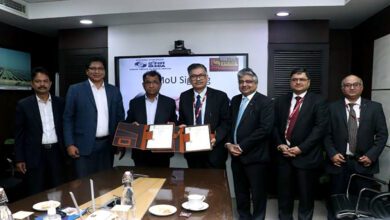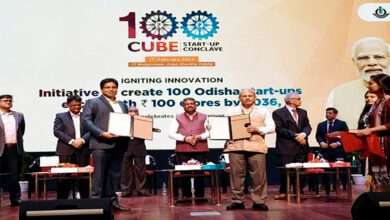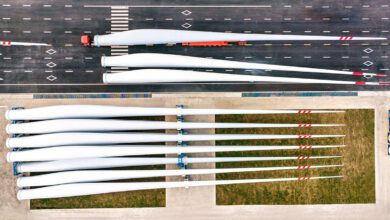Piyush Sohani, the Managing Director of Sistema.bio India, is a renewable energy professional and engineer driven by a passion for sustainable solutions. His interest in the renewable energy industry was sparked during his engineering studies when he observed the energy challenges faced by rural households in India. With nearly 80% of these households unable to afford LPG cylinders, he questioned why there wasn’t a renewable energy alternative available to them. This curiosity led him to enter the renewable energy industry and introduce biogas technology to Indian farmers. Over the years, Sistema.bio has successfully provided biogas technology to over 50,000 farmers in India, enabling them to embrace renewable energy and increase their productivity through sustainable organic farming.
In an exclusive interview with our Editor – Keshav Raina, Piyush explains Biogas technology in India and Sistema.bio’s technological innovation primarily for the small farmers of India.

What sparked your interest in the renewable energy industry?
I’m a renewable energy professional and an engineer at heart. During my engineering studies, I frequently visited villages and conducted energy surveys. It struck me that nearly 80% of rural households couldn’t afford LPG cylinders, leaving them reliant on firewood for cooking. As an engineer, this ignited my curiosity, prompting me to question why there wasn’t a renewable energy alternative available to provide them with an option to use sustainable energy sources.
This realization led me to enter the renewable energy industry about 12 years ago. Since then, we’ve successfully provided biogas technology to over 50,000 farmers in India. As a result, they no longer depend on LPG for cooking and have embraced renewable energy through biogas. This solution not only caters to their energy needs but also benefits them by providing bio-fertilizer for sustainable organic farming.
Tell us about Sistema.bio’s entry into India and its presence across the country?
After securing projects in 2017, Sistema.bio ventured into India and officially registered the company in 2018. Presently, our company is headquartered in Pune, with a manufacturing facility located in the Chakan Industrial Area. This facility enables us to produce up to 1,00,000 biodigesters annually. Currently, we have a presence in 21 states across India.
How does Sistema.bio’s innovative biogas technology benefit Indian farmers and contribute to the advancement of the farming sector?
One of the main advantages of biogas technology is its direct benefit for farmers facing energy challenges in rural parts of India. These farmers often struggle with high energy costs and an unreliable power supply, which hampers their agricultural activities.
Additionally, when it comes to fertilisers, farmers are compelled to choose chemical options that are both expensive and detrimental to their soil health. Our biogas technology effectively addresses these issues.
The concept of biogas technology is relatively simple and has been in use for several decades. It involves utilising the organic waste, such as animal waste, available on the farm. We process this waste to generate biogas, which primarily consists of methane and carbon dioxide. Methane, being an energy-rich gas, has various applications such as cooking, meeting thermal energy needs, or converting milk into products like mawa or ghee. Additionally, farmers can convert biogas into electricity using a biogas generator to power their electrical appliances.
Furthermore, the by-product of this technology is a potent organic fertiliser known as bio slurry. When applied to crops, this digested fertiliser significantly reduces farmers’ reliance on traditional fertilisers, by up to 70%, while providing immense benefits to their fields.
Operating and maintaining a biodigester can be challenging for small farmers with limited resources. How does Sistema.bio address this issue?
Our technology is specifically tailored for small-scale farmers in rural parts of India. One key advantage is its ease of transportation to remote areas. The system can be conveniently folded and transported, facilitating accessibility. Additionally, it requires minimal space, making it suitable for small farmers who possess just a few cows. Installing the biogas system in their backyard only necessitates approximately five square metres of space.
Regarding maintenance and service, we design every aspect of the technology to ensure long-term functionality. Once we install the system, we intend it to operate smoothly for a span of 10 to 15 years. Our company provides a 10-year warranty, but the actual lifespan of the system exceeds 15 years. Notably, the technology does not involve complex machinery or moving parts. We also provide comprehensive training to farmers, enabling them to operate the system effectively on a daily basis. Additionally, we have customer service centres located across the country, wherever we have our operations.
Affordability is a crucial aspect when it comes to introducing new technology to small farmers. How does Sistema.bio ensure that its biogas technology remains accessible to farmers with limited financial resources?
Let me give you an example. On average, a farmer spends around ₹1,000 to ₹1,200 per month on an LPG cylinder, totaling roughly ₹12,000 to ₹15,000 annually. Additionally, there are costs incurred for chemical fertilisers. By utilising our biogas system, farmers can achieve a return on investment (ROI) breakeven within approximately 18 to 24 months.
Our technology is designed to be affordable for farmers of varying income levels. We understand that farmers have different financial capacities, ranging from low-income small farmers to those with more cows and larger landholdings. To ensure accessibility, we have developed a business model that involves collaborating with various organisations to reduce distribution costs. For instance, we have partnered with the National Dairy Development Board (NDDB), which has a cooperative network of approximately 17 million farmers across India. Through these cooperatives, we promote our technology, reducing our promotion costs.
Additionally, we have secured certification from the Ministry of New and Renewable Energy (MNRE), Government of India. This allows farmers who purchase our system to receive subsidies from the government. The central government subsidy amounts to around ₹15,000, and there are additional state government subsidies available in different regions. This subsidy model helps farmers who have limited affordability or cannot afford the technology.
Furthermore, we leverage climate financing, which has seen significant growth due to the international climate change movement. Through this approach, upfront subsidies are provided to farmers, with climate financing mechanisms currently subsidizing up to 80% of the product cost. As a result, farmers only need to pay a minimal upfront cost, allowing them to utilise the biodigesters for the next 10 years.
Crop burning and pollution have become pressing concerns, particularly in the northern part of India. How does Sistema.bio’s technology contribute to environmental benefits, and what are your plans for expanding into this region to improve air quality?
We are currently operational in Uttar Pradesh, Haryana, Rajasthan, and recently expanded our operations to Punjab as well. The key advantage of our technology is that it eliminates the need for farmers to rely on burning firewood or cow dung cakes for cooking. By using biogas, they can completely avoid the emissions and smoke generated during cooking and heating. Biogas serves as an ideal solution for minimising emissions associated with these activities, making it highly beneficial.
Our technology specifically utilises animal waste rather than agricultural waste. Dairy farmers, for instance, with two to three cows or more, can use their animal dung as input for biodigester. This will result in the generation of methane gas. While we are currently working on a technology to use agricultural residue as well, that is a separate segment and will be a different technology altogether.
Transporting cow dung from small farmers to your biodigester facility might pose logistical challenges. How do you plan to address this issue and ensure accessibility for farmers with limited resources?
Our approach is straightforward and specifically targets the 7 crore small farmers in India who engage in dairy activities and sell milk. For those small farmers who own 2 or 3 cows and have a landholding of around 2 to 3 acres, the cow dung generated by these animals is primarily used for religious rituals, accounting for a minimal portion (approximately 1% or less). However, in many North Indian regions, farmers commonly use cow dung to make dried cow dung cakes for cooking purposes. From an engineering perspective, this method of burning cow dung is inefficient, resulting in excessive smoke generation and longer cooking times.
Our proposed solution offers a simple alternative. By placing the cow dung into the biodigester, it generates a clean and efficient cooking gas similar to LPG. This enables farmers to enjoy smoke-free cooking that is both efficient and faster. Moreover, the cow dung does not go to waste. After undergoing digestion in the biodigester, it transforms into a nutrient-rich bio-slurry, which farmers can use as a valuable organic fertilizer for their farms. By utilising this bio-slurry, farmers can enhance their agricultural productivity.
We aim to install biodigesters near the locations where these farmers keep their animals. Since these farmers already clean the dung from their cattle, they can directly input it into the biodigester. The biodigester generates gas. We can transport this gas through a gas pipeline to nearby households or communities, providing them with cooking gas.
Your new production facility in Pune has an annual capacity of 1 lakh units. Could you share your timeline for reaching full production capacity and your plans for increasing it in the future?

We have already commenced manufacturing operations at our newly established production facility. We anticipate reaching full capacity by the middle of next year, around mid-2024. In the current financial year, we are projected to produce approximately 60,000 biodigester units. These units will not only serve the Indian market but also cater to demand in Africa. Going forward, we have plans to scale up our production capacity, potentially increasing from one lakh units to even higher volumes. We are actively working on implementing an automation strategy to streamline our manufacturing lines, thereby further enhancing our production capacity.
Considering the capacity of your new facility reaching one lakh units, could you provide an estimate of the electricity generation or gas supply potential it holds for the people?
Our manufacturing unit focuses on producing biodigester units. These units are then provided to farmers for generating biogas on their individual farms. As a rule of thumb, each biodigester has a capacity of approximately 2 cubic metres of gas per day. This translates to saving around 1 to 1.5 LPG cylinders per month. Once our manufacturing facility operates at full capacity, we estimate saving approximately 1 lakh to 1.5 lakh cylinders of gas every month, considering the Indian context.
Allow me to illustrate with an example from Nagpur. Recently, we completed a project in a dense forest area. There we installed 10,000 biodigesters in 10,000 households across four blocks of Nagpur. This implies a significant reduction in cylinder usage within that small district alone. By leveraging biodigester technology, we can contribute to reducing India’s LPG imports and subsidy expenses.
Could you explain how your technology differentiates from other biogas plants and its impact on production? Additionally, could you shed some light on the cost comparison between traditional methods and your technology?
The primary advantage of our technology lies in its superior construction compared to the older cement and civil-constructed biogas plants used in rural areas. In earlier construction methods, ensuring an airtight chamber, which is crucial for biogas generation, was challenging. Due to cracks and improper construction practises, air would seep into the system, leading to gas leakage or inadequate gas production.
In contrast, our technology involves factory manufacturing, which enables strict quality control. The units are produced in a controlled environment and then transported to the farmers’ houses for installation. The materials used in our technology have a lifespan of over 15 years. They unaffected by rain, heat, weather changes, or sunlight. This ensures a leak-proof and long-lasting system.
Furthermore, our technology offers significant cost advantages compared to traditional cement and brick-based biogas plants. The conventional systems, particularly the 2 cubic metre family-sized units, still cost around ₹35,000 to ₹40,000. In contrast, our technology costs less than 20% of that price. Moreover, with government subsidies and carbon financing, our solution becomes highly affordable for the targeted regions.
Can you provide an estimate of the turnaround time to recover the return on investment (ROI) for this facility? Additionally, what is the anticipated employment impact of the facility?
I would estimate that the return on investment (ROI) from factory will occur within a span of approximately two years. In terms of employment, we anticipate employing around 100 technicians directly in our factory, which will provide direct job opportunities. Additionally, we expect to generate approximately twice the number of indirect employment opportunities, resulting in overall employment growth.
Could you elaborate on your strategies to achieve 1% reduction in GHG emissions by 2030? Additionally, do you believe there is potential to exceed this goal?
Achieving a 1% reduction in greenhouse gas (GHG) emissions is indeed a significant goal, but we believe it is possible. Our vision is to extend the reach of biogas technology to every household in India. We are considering that there are approximately 7 crore dairy farmers in the country. To achieve 1% emission reduction target, we will also expand our operations in South Asia and Southeast Asia.
Furthermore, we are committed to continuous improvement and innovation in our technology. We are exploring ways to enhance the application of biogas in various sectors, such as electricity generation and thermal applications. One example is the development of biogas water heaters, which allow farmers to utilise biogas for water heating purposes. These incremental innovations will contribute to a broader utilisation of biogas and ultimately help us reach our goal of reducing GHG emissions by 1%.
Could you elaborate on the adaptability and utilization of biogas-generated electricity?
Our value proposition is simple and direct. We offer biodigester technology and biogas electricity solutions to farmers in need. Many farmers in rural areas face challenges with an unreliable electricity supply and resort to using diesel generators, incurring high fuel costs that continue to rise. For these farmers, our concept is straightforward. They can harness their own resources, specifically animal waste, to generate biogas at no additional cost. This biogas can then be used to produce electricity, providing them with a reliable and cost-effective energy source. The adaptability of our solutions is evident as we observe 100% utilisation of electricity generated from biogas among our installed systems.
With India being such a vast country, some people might question the decision to have a single mega facility in Pune. Do you think it would have been wiser to establish three or four smaller facilities scattered around?
This is just the beginning of our journey. Looking ahead three to four years from now, we envision significant growth and expansion. We may look back one day and say that this was the first, and smaller facility.
Our plan includes establishing additional manufacturing facilities or increasing the capacity of existing ones. Currently, our focus is on establishing a facility that strategically caters to various regions in India, including the South, North, West, and central parts of the country. Pune was chosen as the location for our first manufacturing facility due to its advantageous logistical position. We hope to initiate more manufacturing facilities and expand our operations to meet the growing demand for our products.
When it comes to the widespread adoption of biogas in India, what are the main challenges and opportunities? How can these challenges be effectively addressed?
One of the main challenges we face is that biogas technology is still in its early stages. Similar to the growth trajectory of the solar industry 20 to 15 years ago, biogas is currently in the initial phase. Concerted efforts from all stakeholders are needed to drive the industry-wide scale-up. Creating awareness among users throughout India is crucial so that they realise they can generate their own cooking gas by installing a biodigester instead of relying on external LPG sources. This awareness-building process is a significant challenge.
Another challenge is the need for skilled professionals in the biogas industry. Given its early stage, there is a scarcity of individuals with the required expertise. Therefore, skill development initiatives are necessary to address this gap.
Additionally, fostering technological innovation is vital. Collaboration between government bodies, industries, and other stakeholders is essential to driving innovation in biogas appliances. For instance, the introduction of innovative appliances like biogas rice cookers can greatly enhance the sector. The growth of the biogas industry requires addressing three challenges—awareness generation, skill development, and technological innovation.
How would you assess the current government policy regarding biofuels in India? Is it sufficiently supportive, or are there areas that require further attention?
Currently, the Government’s policy regarding biogas is favourable. The Ministry of New and Renewable Energy (MNRE) recently introduced a five-year bioenergy programme. This aims to promote bioenergy across the country. This initiative by the MNRE is commendable and contributes to the growth of the sector.
However, to further encourage the development of the biogas industry, it is essential to create an environment that attracts more players. Simplifying the regulatory framework would be beneficial, considering the early stage of the industry. For instance, reducing the Goods and Services Tax (GST) on biodigesters, currently set at 5%, can help lower costs for consumers. Implementing additional policies that support the growth of the industry would be advantageous.
Overall, the government’s efforts are laudable. However, there is still scope for the development of more policies that facilitate the growth of the biogas sector.
Watch the full interview on YouTube-












